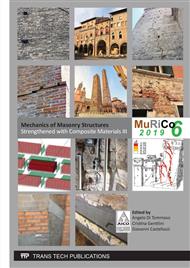[1]
F. Carozzi and C. Poggi, Mechanical properties and debonding strength of Fabric Reinforced Cementitious Matrix (FRCM) systems for masonry strengthening,, Composites Part B: Engineering, Vols. 70,, pp.215-230, (2015).
DOI: 10.1016/j.compositesb.2014.10.056
Google Scholar
[2]
F. Carozzi, A. Bellini, T. D'Antino, G. de Felice and F. Focacci, Experimental investigation of tensile and bond properties of Carbon-FRCM composites for strengthening masonry elements,, Composites Part B: Engineering, vol. 128, pp.100-119,, (2017).
DOI: 10.1016/j.compositesb.2017.06.018
Google Scholar
[3]
A. D'Ambrisi, L. Feo and F. Focacci, Experimental and analytical investigation on bond between Carbon-FRCM materials and masonry,, Composites Part B: Engineering, vol. 46, pp.15-20, (2013).
DOI: 10.1016/j.compositesb.2012.10.018
Google Scholar
[4]
E. Franzoni, C. Gentilini , M. Santandrea and S. Zanotto, Durability of steel FRCM-masonry joints: effect of water and salt crystallization,.
DOI: 10.1617/s11527-017-1070-2
Google Scholar
[5]
E. Franzoni, C. Gentilini , M. Santandrea and C. Carloni, Effects of rising damp and salt crystallization cycles in FRCM-masonry interfacial debonding: Towards an accelerated laboratory test method,, Construction and Building Materials, vol. 175, p.225–238, (2018).
DOI: 10.1016/j.conbuildmat.2018.04.164
Google Scholar
[6]
E. Franzoni, C. Gentilini, M. Santandrea and C. Carloni, Effects of rising damp and salt crystallization cycles in FRCM-masonry interfacial debonding: Towards an accelerated laboratory test method,, Construction and Building Materials, vol. 175, pp.225-238, 201.
DOI: 10.1016/j.conbuildmat.2018.04.164
Google Scholar
[7]
C. Gentilini, E. Franzoni, M. Santandrea and C. Carloni, Bond analysis of FRCM strengthened masonry subjected to salt attack,, 10th International Masonry Conference,IMC 2018; Milan; Italy; 9 July 2018 through 11 July 2018; , (2018).
DOI: 10.1016/j.conbuildmat.2018.04.164
Google Scholar
[8]
Z. Aljazaeri and J. Myers, Durability performance of FRCM composite bonded to concrete under different environmental aging conditions,, in Proceedings of the 8th International Conference on Fibre-Reinforced Polymer (FRP) Composites in Civil Engineering, CICE 2016, (2016).
Google Scholar
[9]
BS EN 772-1:2011+A1:2015 Methods of test for masonry units. Part 1: Determination of compressive strength.
Google Scholar
[10]
CEN, EN 12390-6 Testing hardened concrete - Part 6: Tensile splitting strength of test specimens.,, (2009).
DOI: 10.3403/02128962
Google Scholar
[11]
A. Hillerborg, «The theoretical basis of a method to determine the fracture energy GF of concrete.,» Materials and structures, vol. 18(4), pp.291-296, (1985).
DOI: 10.1007/bf02472919
Google Scholar
[12]
G. V. Guinea, J. Planas and M. Elices, Measurement of the fracture energy using three-point bend tests: Part 1 Influence of experimental procedures,, Materials and Structures, vol. 25, pp.212-218, (1992).
DOI: 10.1007/bf02473065
Google Scholar
[13]
C. G. Hoover, Z. P. Bažant, J. Vorel, R. Wendner and M. Hubler, Comprehensive concrete fracture tests: description and results.,, Engineering fracture mechanics, vol. 114, pp.92-103, (2013).
DOI: 10.1016/j.engfracmech.2013.08.007
Google Scholar
[14]
K. S.p.A., http://products.kerakoll.com/catalogo_dett.asp?idp=7386,, [Online].
Google Scholar
[15]
BS EN 1015-11:1999 Methods of test for mortar for masonry. Part 11: Determination of flexural and compressive strength of hardened mortar.
DOI: 10.3403/01905442u
Google Scholar
[16]
BS EN 1936:2006 Natural stone test methods - Determination of real density and apparent density, and of total and open porosity.
DOI: 10.3403/30149240
Google Scholar
[17]
M. Santandrea, I. Imohamed, C. Carloni, C. Mazzotti , S. de Miranda and F. Ubertini, A study of the debonding mechanism in steel and basalt FRCM-masonry joints,, in Brick and Block Masonry: Proceedings of the 16th International Brick and Block Masonry Conference, Padova, Italy, (2016).
DOI: 10.1201/b21889-52
Google Scholar
[18]
C. Tedeschi, S. Perego and M. Valluzzi, Study on local effects of aggressive environmental conditions on masonry strengthened with FRCM,, in Brick and Block Masonry: Trends, Innovations and Challenges - Proceedings of the 16th International, 16th International Brick and Block Masonry Conference, IBMAC 2016; Padova; Italy; 26 June , (2016).
DOI: 10.1201/b21889-53
Google Scholar
[19]
ASTM C1006 - 07(2013) Standard Test Method for Splitting Tensile Strength of Masonry Units.
Google Scholar
[20]
E. Franzoni, C. Gentilini , M. Santandrea , S. Zanotto and C. Carloni, Durability of steel FRCM-masonry joints: effect of water and salt crystallization,, Materials and Structures/Materiaux et Constructions, vol. 50, no. 201, (2017).
DOI: 10.1617/s11527-017-1070-2
Google Scholar


